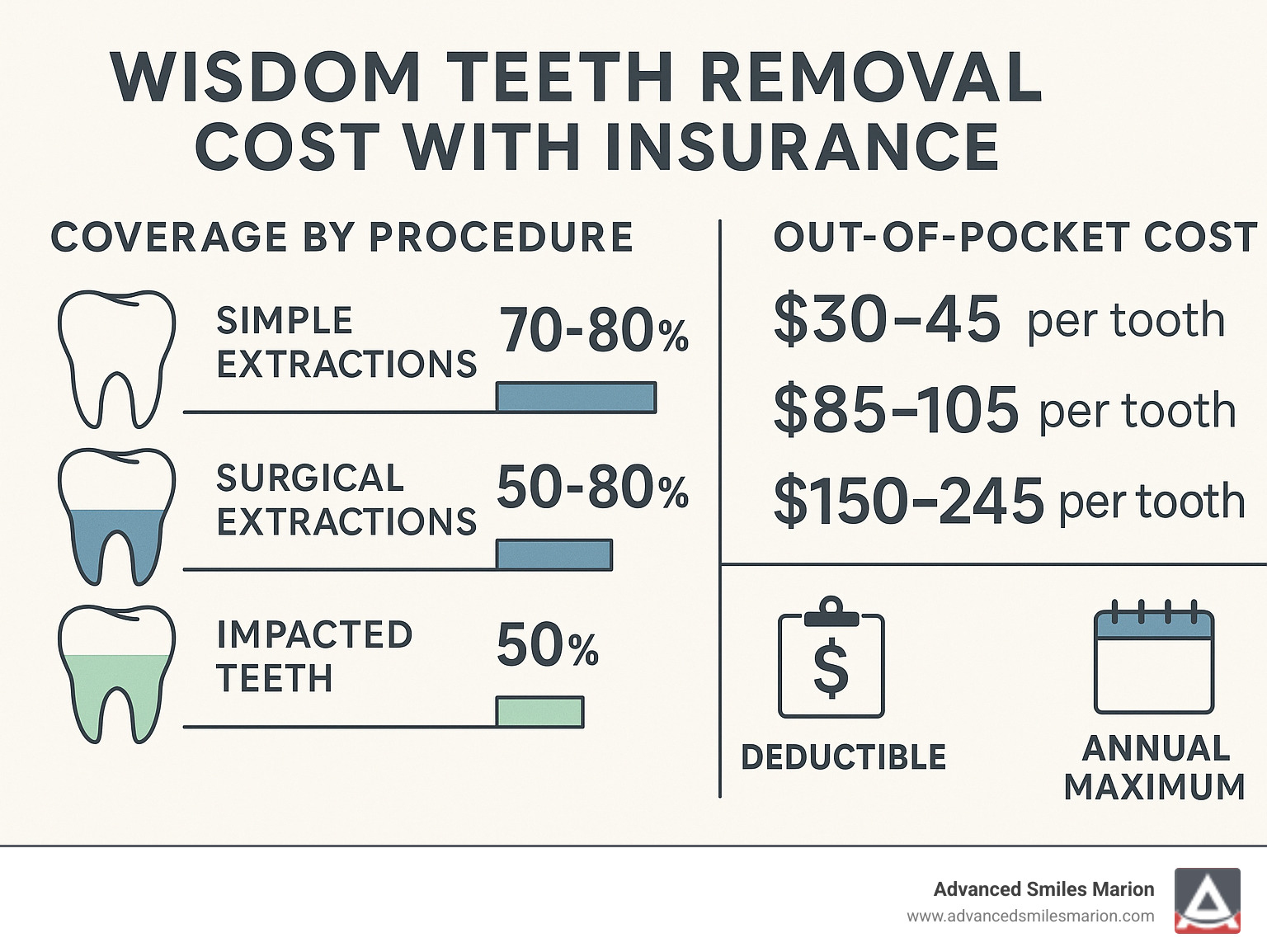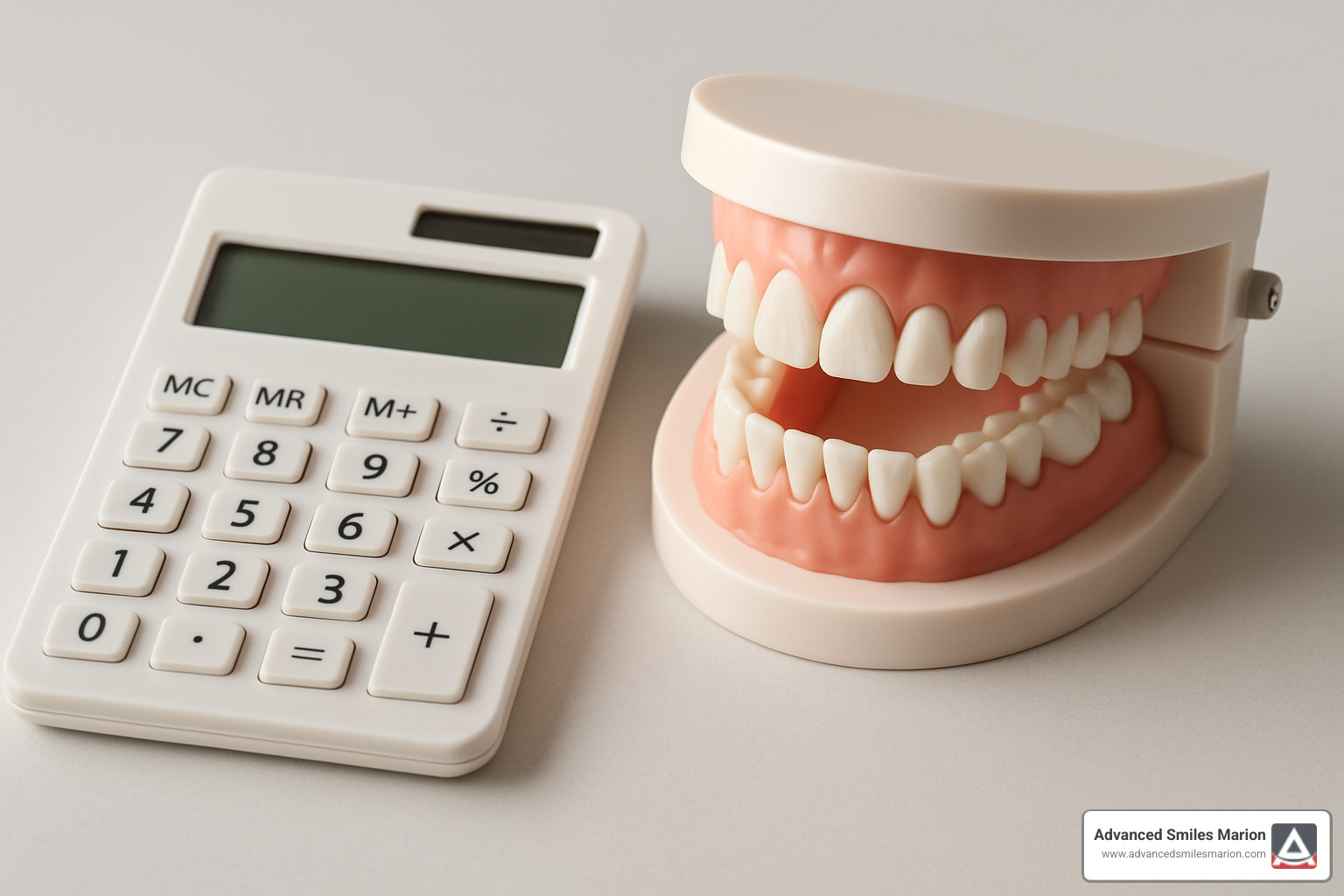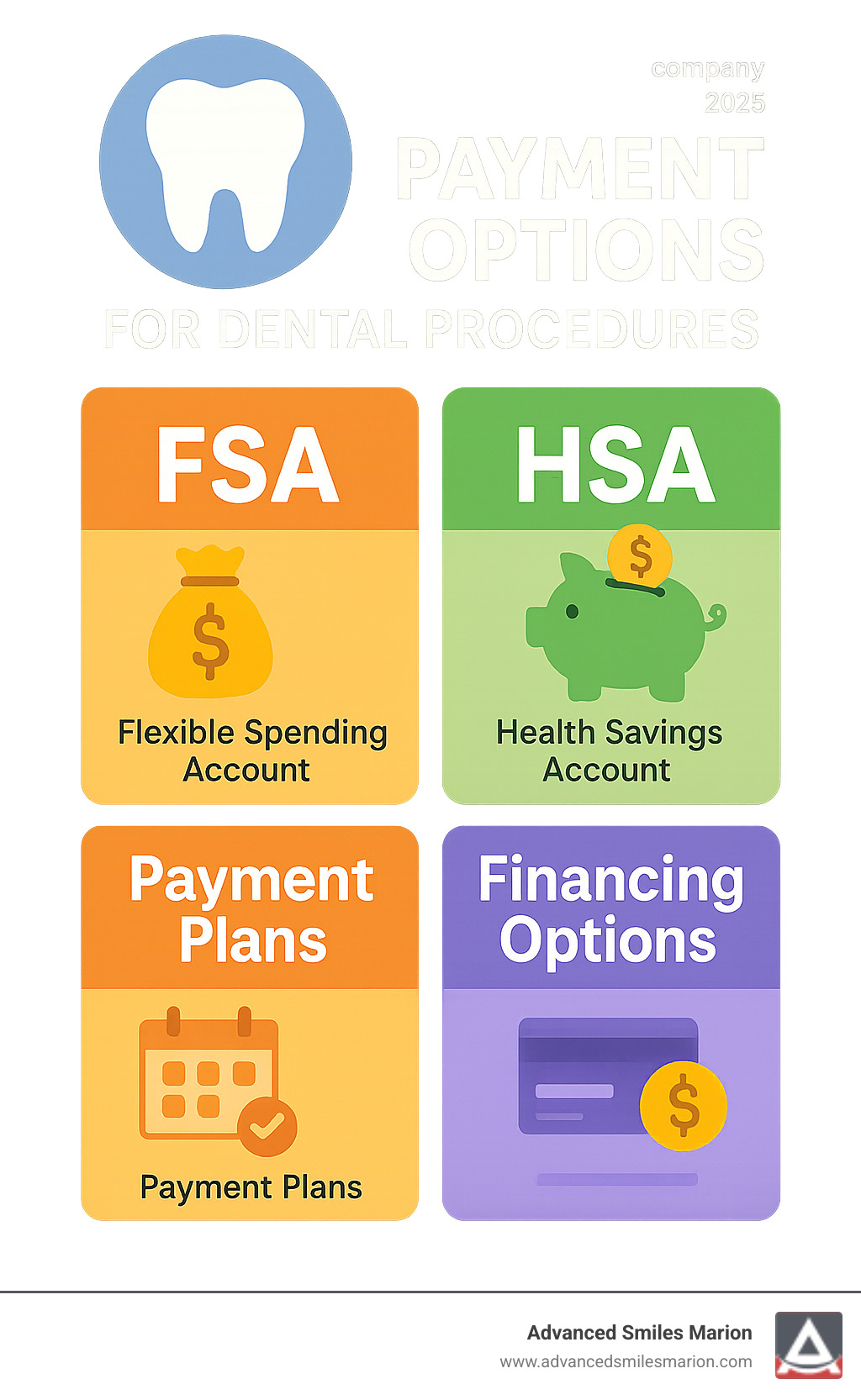Why Understanding Insurance Coverage for Wisdom Teeth Removal Matters
Wisdom teeth removal cost with insurance often surprises patients because coverage varies widely. Most dental plans pay 50-80% of the fee, yet the exact amount depends on how your policy labels the procedure, whether your dentist is in-network, and if you have reached your annual maximum. Delaying necessary treatment can lead to more complex and costly problems down the road, such as infection, cysts, or damage to adjacent teeth, turning a manageable expense into a significant financial burden.
Quick snapshot of typical coverage:
- Simple extractions: insurance pays 70-80% (you pay roughly $30-45 per tooth)
- Surgical extractions: insurance pays 50-80% (you pay roughly $85-105 per tooth)
- Fully impacted teeth: insurance pays about 50% (you pay roughly $150-245 per tooth)
- Annual benefit cap: $1,000-$1,500 for most plans
Because nearly 90% of people have at least one impacted third molar, understanding these numbers can make a real difference to your wallet. At Advanced Smiles Marion, our highly trained dentists and dedicated support team are experts at navigating the complexities of dental insurance. We review every patient’s policy, submit pre-treatment estimates to get a clear picture of your benefits, and provide written fee statements before any treatment begins, ensuring total transparency.

Handy links for deeper dives:
The Full Price Tag: Understanding Wisdom Teeth Removal Costs Without Insurance

Before insurance kicks in, it is useful to know the raw numbers. A straightforward removal of a fully erupted tooth may cost about $75-$200 per tooth in central Ohio, while a surgical extraction for a deeply impacted tooth can range from $250-$600 per tooth. The final figure reflects:
- Number of teeth extracted (often cheaper as a bundled fee for four at once)
- Complexity (simple vs. surgical)
- Type of anesthesia (local, nitrous oxide, or IV sedation)
- Imaging and consultation visits
- Location and provider type (general dentist vs. oral surgeon)
Anesthesia choice is a significant cost factor. Local anesthesia numbs the immediate area, allowing you to remain fully awake with minimal cost. Nitrous oxide, or "laughing gas," adds a layer of relaxation for a moderate fee. IV sedation, administered by a trained professional, provides a "twilight sleep" state, ideal for anxious patients or complex cases, but it carries the highest cost.
At Advanced Smiles Marion we streamline fees by offering packaged pricing when you remove all four third molars in one visit, saving repeat anesthesia and follow-up costs. For specific figures, see our Cost of Wisdom Teeth Removal resource.
Simple vs. Surgical Extractions: Why the Gap?
| Extraction Type | Average Fee Range | Key Details | Typical Anesthesia |
|---|---|---|---|
| Simple | $75-$200 | Tooth is visible and mobile | Local only |
| Surgical | $250-$600 | Incision, bone removal, sutures | Local + sedation |
How Impaction Level Raises the Price
Soft-tissue impaction needs a small incision and mild bone removal; partial-bony requires more bone reduction; full-bony involves sectioning the tooth and longer surgery time. A full-bony impaction is the most complex, as the tooth is completely encased in the jawbone. This often requires the surgeon to carefully cut the tooth into smaller pieces for safe removal, increasing the time and skill required. Greater complexity usually means an oral surgeon, stronger sedation, and a higher fee. Learn more in our Average Cost of Oral Surgery Extraction guide.
Breaking Down the Wisdom Teeth Removal Cost with Insurance
Insurance uses the 100/80/50 rule for most PPO plans:
- 100% preventive care
- 80% basic procedures (often simple extractions)
- 50% major procedures (most surgical extractions)
But your real cost depends on deductibles, annual maximums, and network status. Always ask your provider to submit a pre-treatment estimate so you know exactly how much of your yearly cap remains. This document is your best tool for financial planning.
Typical Coverage by Procedure
- Simple extraction (basic): plan pays 70-80%; you pay 20-30%
- Surgical extraction (major): plan pays ~50%; you pay ~50%
HMO plans can have lower fees but stricter rules, often requiring referrals and limiting you to a specific list of dentists. PPO plans offer more dentist choice, allowing you to see out-of-network providers, though your out-of-pocket costs will be lower if you stay in-network. Advanced Smiles Marion files all paperwork for you so benefits are maximized, regardless of your plan type.
Real-World Cost Examples
- Sarah’s single simple extraction: $160 fee. Insurance covers 80% ($128). Sarah pays $32.
- Mike’s two impacted molars: $1,000 total. Insurance covers 50% ($500). Mike pays $500.
- Jessica’s four surgical extractions near her $1,200 annual maximum: Her total bill is $2,200. If treatment is split between December and January, insurance can contribute up to $2,400 over two benefit years. By scheduling two teeth in December ($1,100 cost) and two in January ($1,100 cost), she can use her $1,200 maximum from the first year and the renewed $1,200 maximum from the second year, potentially cutting her personal cost nearly in half.
Decoding Your Dental Plan: Key Terms That Impact Your Final Cost

Four terms dictate most of your bill:
- Deductible – what you pay before benefits begin (often $50-$100 for an individual). This amount resets annually.
- Coinsurance – your share after the deductible is met (typically 20% for basic care and 50% for major procedures).
- Annual maximum – the absolute total the plan will pay for your care in a benefit year (usually $1,000-$1,500). It's crucial to know that these maximums have not kept pace with the rising cost of dental care over the years.
- Waiting period – the time you must be enrolled in a plan before coverage for major care activates (can be 0-12 months). Insurers use this to prevent individuals from signing up only to have a costly procedure and then immediately cancel the policy.
How the Parts Work Together
If your deductible is $50 and coinsurance 20%, a $400 simple extraction becomes:
- First $50 paid by you (deductible)
- Of the remaining $350, insurance covers 80% ($280)
- You pay 20% ($70)
Total out-of-pocket = $120. If you had already paid your deductible on a previous procedure that year, your out-of-pocket cost would only be the $70 coinsurance.
Getting a Precise Estimate
Call the number on your insurance card and request coverage details for the exact CDT codes your dentist lists. CDT (Current Dental Terminology) codes are the specific billing codes for every procedure (e.g., D7210 for a simple surgical extraction of an erupted tooth, or D7240 for a complex full bony impaction). Our team then submits a pre-authorization with these codes, and you’ll receive an Explanation of Benefits (EOB) outlining what insurance is expected to pay and your portion. This avoids last-minute surprises.
Beyond the Procedure: Additional Costs and Special Circumstances
Consultation visits, panoramic X-rays, optional 3-D cone-beam images, and anesthesia upgrades can add $100-$400 to your total. A panoramic X-ray provides a comprehensive two-dimensional view of your entire mouth, essential for planning the extractions. A 3-D cone-beam CT (CBCT) scan may be recommended if your wisdom teeth are positioned precariously close to the major nerves in your jaw. While an added expense, this detailed imaging provides a crucial roadmap for the surgeon to prevent nerve damage. Prescription medications and a post-op check are usually modest, and our office often bundles the first follow-up at no cost.
Does Medical Insurance Ever Help?
Medical insurance may step in if removal is required for non-dental health reasons—severe infection, cysts, tumors, or trauma that necessitate hospital care. This is particularly relevant in cases of significant pathology finded during an exam, such as large cysts or tumors that extend beyond the normal scope of dental care, or after a traumatic facial injury. It can also apply if an extraction is a necessary prerequisite for another medical procedure, like an organ transplant or radiation therapy. Proper documentation from our dentists, including letters of medical necessity, ensures the claim is coded correctly for medical review. For broader context read: When is oral surgery covered by medical insurance?
Smart Solutions for Your Remaining Balance

Even with coverage, timing matters. Scheduling part of your care in December and the rest in January can double the benefits available by tapping into two separate annual maximums.
Advanced Smiles Marion also offers interest-free payment plans and third-party financing with promotional rates, allowing you to spread the cost over manageable monthly payments.
Use Pre-Tax Dollars
Flexible Spending Accounts (FSAs) and Health Savings Accounts (HSAs) both cover deductibles, coinsurance, and any charges above your annual max. Because contributions are pre-tax, you save the equivalent of your tax bracket. A key difference is that FSAs are typically employer-owned with a "use-it-or-lose-it" rule each year, while HSAs are owned by you, roll over indefinitely, and can even function as a retirement savings vehicle.
No Insurance? Consider Our Dental Wellness Plan
Designed for individuals and families without dental coverage, our Wellness Plan delivers discounted fees on all procedures—plus two cleanings, exams, and necessary X-rays a year—without waiting periods or yearly maximums. This eliminates the common frustrations of traditional insurance, like claim denials, waiting periods for major work, and yearly caps on how much care you can receive. Members also receive priority access for emergencies, often same-day.
Frequently Asked Questions about Wisdom Teeth Removal Costs
What will I pay out of pocket with insurance?
For a simple extraction, many patients spend $30-$75 per tooth after benefits. Surgical removal of an impacted tooth may run $200-$300 per tooth out of pocket. Your deductible status, remaining annual maximum, and whether your dentist is in-network are the biggest variables that can shift this number up or down.
Does insurance cover simple and surgical extractions differently?
Yes. Simple extractions are usually classed as basic services (about 80% coverage). Surgical extractions, which require an incision and are more complex, are considered major services (about 50% coverage). Always confirm how your specific plan defines each procedure code.
Is sedation for wisdom teeth removal covered by insurance?
Coverage for anesthesia varies significantly. Local anesthetic is almost always included in the cost of the extraction. However, sedation options like nitrous oxide or IV sedation may only be partially covered or not covered at all, often depending on whether the procedure is deemed medically complex by the insurer. Always verify this with your plan beforehand.
Why request a pre-treatment estimate?
It is the single best way to get an accurate financial picture before your procedure. It locks in your expected cost, verifies the dentist is in-network, confirms how much of your annual maximum will be used, and lets you arrange FSA/HSA dollars or financing before the appointment. Our office handles this paperwork for every wisdom-tooth patient to ensure clarity and peace of mind.
Conclusion: Partner with a Team Focused on Your Health and Budget
Most dental plans cover 50-80% of wisdom-tooth removal. Advance planning—verifying deductibles, coinsurance, and annual maximums—lets you minimize out-of-pocket costs. When insurance leaves a balance, FSAs, HSAs, and flexible payment plans from Advanced Smiles Marion keep care affordable. Our commitment is to blend this financial transparency with world-class clinical care, ensuring your procedure is not only affordable but also performed with the highest standards of safety and comfort.
Our Marion, OH practice combines advanced technology, including laser therapy for TMJ pain and improved soft-tissue healing, with a highly educated team committed to ongoing training. We file all insurance claims, provide transparent estimates, and offer same-day emergency appointments whenever possible to address your needs promptly.
Ready to learn your exact wisdom-tooth estimate? Schedule a consultation today—we’ll explain every clinical and financial detail so you can move forward with confidence.

Panel 6: Hope on the Horizon
The mural culminates in a vision of Marion's future, one marked by technological advancements, sustainability, and community togetherness. The cardinal, elevated above a futuristic cityscape, looks ahead with optimism, its backdrop a blend of colors signifying hope.

Get in touch
Have any questions? Want to learn more?

